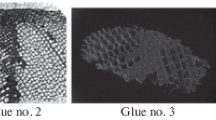Abstract
Complex accelerated testing results on the strength and stability of glued joints obtained by separate applications of binder and hardener to glued surfaces in wooden structures are presented. The obtained data confirm the possibility of switching the wooden structure industry to more manufacturable melamineurea-formaldehyde resin-based adhesives with components separately applied to glued surfaces.
Similar content being viewed by others
References
GOST 20850-84. Wooden Glued Constructions. Basic Technical Conditions.
SNiP 11-25-80. Wooden Glued Construction. Design Standards.
L. M. Koval’chuk, Production of Wooden Glued Constructions, 3rd ed. (rev. ext.) (RIF Stroimaterialy, Moscow, 2005) [in Russian].
R. Z. Temkina, Synthetic Adhesives in Carpentry (Lesnaya prom., Moscow, 1971) [in Russian].
L. M. Koval’chuk, Gluing Wood in the Field of High-Frequency Currents (Goslesrosbumizdat, Leningrad, 1960) [in Russian].
A. S. Freidin, The Strength and Durability of Adhesive Joints (Khimiya, Moscow, 1971) [in Russian].
A. S. Freidin, et al., Predicting the Properties of Adhesive Joints of Wood (Lesnaya prom., Moscow, 1980) [in Russian].
A. S. Freidin, Prochnost’ i dolgovechnost’ kleevykh soedinenii, (The Strength and Durability of Adhesive Joints) Ed. by G. V. Movsisyan (Khimiya, Leningr. otd., Leningrad, 1980) [in Russian].
A. S. Freidin, Properties and Calculation of Adhesive Joints (Khimiya, Moscow, 1990) [in Russian].
A. S. Freidin, Polymer Aqueous Adhesives (Khimiya, Moscow, 1985) [in Russian].
GOST 15613.1-84. Glued Solid Wood. Methods for Determination of the Ultimate Strength of the Adhesive Joint in Shear Parallel to the Fibers.
GOST 25884-83. Glued Wood Constructions. The Method for Determination of the Strength of Adhesive Joints in Layered Chipping.
GOST 17005-82. Glued Wood Constructions. The Method for Determination of Water-Resistant Adhesive Joints.
GOST 17580-82. Glued Wood Constructions. Method for Determination of Resistance of Adhesive Joints to Cyclic Temperature and Humidity Effects.
GOST 20850-74. Glued Wood Constructions. General Technical Conditions.
Recommendations for Testing Wooden Constructions (TsNIISK im. V.A. Kucherenko, Moscow, 1976) [in Russian].
Author information
Authors and Affiliations
Corresponding author
Additional information
Original Russian Text © M.I. Molchanov, L.M. Koval’chuk, 2009, published in Klei. Germetiki. Tekhnologii, 2009, No. 12, pp. 21–28.
Rights and permissions
About this article
Cite this article
Molchanov, M.I., Koval’chuk, L.M. Studying possibility of using melamine-urea-formaldehyde resin-based adhesives with separately applied components in wooden structures. Polym. Sci. Ser. D 3, 201–208 (2010). https://doi.org/10.1134/S199542121003010X
Received:
Published:
Issue Date:
DOI: https://doi.org/10.1134/S199542121003010X




